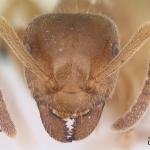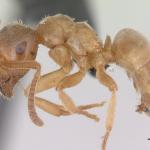Lasius mixtus workers are small and yellowish. The petiole is low with an emarginate dorsal border. There are no standing hairs on scapes or front tibia and body hairs are shorter than L. flavus (Fabricius). Queens are brownish black with head about as broad as alitrunk. Males are brownish black with weakly dentated mandibles.
Throughout the British Isles.
It occurs throughout north Eurasia and Central Europe.
This species is not regarded as scarce or threatened.
This is one of the least thermophilic Lasius species and it inhabits pastures, sparse woodlands and grasslands.
Alates fly in August and September. De-alate females are sometimes found wandering above ground in spring when they can take advantage of the lower aggression shown by their hosts in cold weather.
Nests are founded by taking over a nest of Lasius flavus or another Lasius species. Nests are in the soil sometimes under stones or among roots. Sometimes mound nests of fine soil are constructed.
They forage underground on small invertebrates and tend root-feeding aphids.
2010



